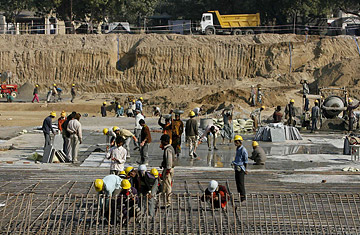
Laborers work at a renovation site of a stadium for the Commonwealth Games 2010 in New Delhi, January 16, 2008.
In November 2003, local officials hailed New Delhi's victory in the race to host the 2010 Commonwealth Games as an opportunity to modernize its infrastructure and showcase the Indian capital as a world-class city. But New Delhi's preparations for the games — which involve Britain and most of its former colonies — have been so tardy and poorly executed that diplomats here joke that workers will still be painting the lanes on the athletic track when the runners take their marks.
The latest setback to the preparations has been a meningitis outbreak among construction workers at the site of the games village: news reports in early March said that nine patients had been treated for the potentially deadly and contagious disease in 10 days. While no deaths were reported, the Hindustan Times reported poor hygiene conditions on the site, which is not altogether surprising given that the Yamuna, on whose eastern bank the site is located, is one ofthe most polluted rivers in the world.
The choice of the 63.5-hectare site for the Games Village — near the picturesque Akshardham Temple — has been controversial from the outset. Conservationists and local villagers protested against construction on the river's floodplains, and have taken the matter to the court. And that's not to mention the fact that it's located alongside a river whose sewer-like stench assaults the nostrils miles before you reach the actual site. Following reports of a meningitis outbreak, the Delhi Development Authority, which is in charge of the site, has refused to allow anyone inside. Though it claims that adequate sanitary provisions have been made inside, villagers living near the games' site say at least 40 people have died and hundreds of workers have fled, fearing the "curse of the river."
While not nearly as prestigious as the Olympics, the Commonwealth Games, which involves some 5,000 athletes from 53 countries, will be the largest sporting event ever staged in India. Having staked India's reputation on the event, New Delhi is spending an estimated $12 billion to prepare the city for the games. With less than three years to go, plans to build state-of-the-art sports facilities and transport infrastructure, including new roads, at least 74 flyovers and new underground subway lines, have yet to be executed. Delhi's dilapidated train stations and airports will also have to be refurbished, and the city will have to add some 40,000 hotel rooms to cater to those expected to visit for the games.
Comparisons with Beijing are inevitable.
In less than half the time available to New Delhi, Beijing has built up an impressive lineup of stadiums for the 2008 Olympic Games. In addition to sprucing up its transport system and taking measures to improve its air quality, Beijing has even had time for over-the-top measures like testing cloud-diffusing technology to ward off untimely rains. But then, as New Delhi's supporters would say, that's because India is a democracy rather than an autocracy: Beijing has not had to contend with citizens' protests the way New Delhi has — from environmentalists protesting construction on the Yamuna's floodplains and conservationists protesting construction of an underground rail link near a historical monument, to motorists protesting a rapid-transit bus system that actually slows traffic down.
For some months now, the authorities have been putting up giant billboards counting down to the Commonwealth Games — presumably to get Delhi-ites enthused about them. The billboards' more important function, however, may be to remind those responsible for preparing the city for this showcase event that time is running out.
